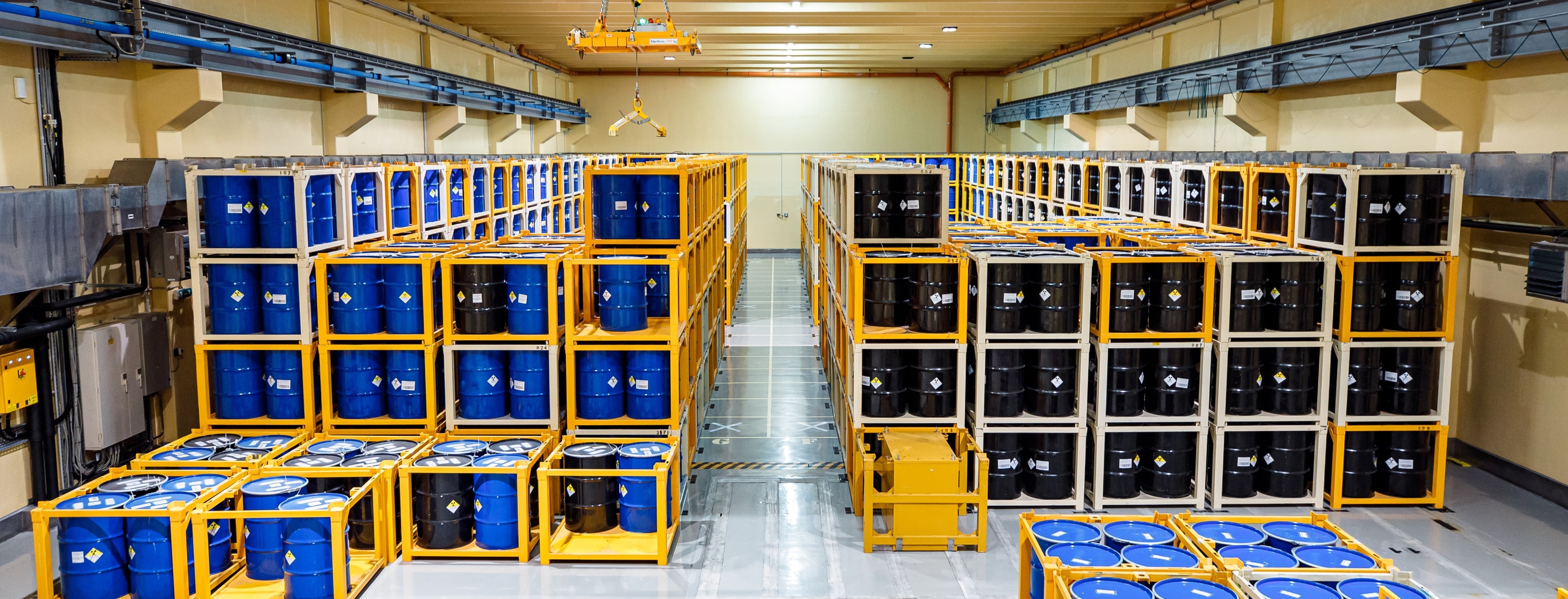

The content of this page will be updated soon.
Managing low and intermediate level NPP radioactive waste
The liquid and solid, low and intermediate level radioactive waste generated by the nuclear power plant must be safely disposed of. Solid radioactive waste generated during the operation of the nuclear power plant is compacted into 200 litre steel drums; liquid wastes are collected in storage tanks. Only solid waste is suitable for final disposal; therefore, liquid wastes must also be solidified before transport to the national repository. Some low and intermediate level radioactive waste will also be generated during the decommissioning of the NPP, which can be disposed of in treated, solidified form.
The National Radioactive Waste Repository (NRWR)
During the operation of the nuclear power plant, besides spent fuel, low and intermediate level radioactive waste is also produced, which must be safely managed and disposed of. For the final disposal of such waste the National Radioactive Waste Repository was established. Waste disposal had been done according to the original storage concept (waste drums placed in reinforced concrete containers; the internal spaces filled with inactive concrete mixture; the resulting waste package is called a monolith block) until 2017. The first storage chamber (I-K1) of the facility was filled up to full capacity in May, 2017. Future waste packages, which are going to be produced by the NPP, will be placed into the I-K2 and subsequent chambers.
The final disposal chambers are located 200-250 metres below surface. Two tunnels provide access to the chambers. The tunnels are 1.7 km long and have a 10% inclination; they are also connected with a cross-tunnel at every 250 metres, providing an escape route in case of an emergency. The almost 6 km long tunnel system is divided into two sections, the radiation controlled area with the in-use storage chambers, and the construction zone. These two sections are separated from each other by sealed gates. Waste packages are disposed to their final resting place in the chambers, meanwhile the construction area allows further expansion of the underground storage area.
According to the storage concept used in chamber I-K1, waste was packaged, compacted and sealed into 200 litre steel drums at the nuclear power plant. Following rigorous inspections (check for physical damage, gamma dose rate on the drum surface and at a 1 m distance, smear sample to check surface contamination, and the inspection of the activity levels in the drums with a software designed especially for the purpose to ascertain that these comply with the activity limits of the NRHT) the representatives of PURAM took over the waste drums, and delivered them to the facility via motorway M6 from Paks, through Bátaszék to Bátaapáti. For delivery a special truck was used with regulatory authorization.
At the technological building nine of these drums were placed in a reinforced concrete container, the space around them was filled with inactive cement mixture. After seven days of rest, these maximum 16-ton waste packages (monolith blocks) were transported to the first chamber marked I-K1, where a special forklift was used to lift them into place. The first chamber was filled in 2017, in 537 containers 4833 drums of was disposed of.
The storage concept of the second chamber (I-K2) is fundamentally different from the previous one. According to the new design the reinforced concrete containers are replaced with so-called compact waste packages (KWP) which are prepared at the nuclear power plant. Four of the same 200 litre steel waste drums are placed in a reinforced steel container with thinner walls. The space around the drums is also filled, however at this time with active cement mixture made from liquid radioactive waste, thus the space between the drums can also be used for radioactive waste disposal. PURAM transports these steel packages by four to Bátaapáti on their regular route after performing the same rigorous inspections. Disposal of these new waste packages required the modification of the chamber design. The steel containers are placed into a reinforced concrete vault in I-K2, not disposed of directly underground, like in the first chamber. The packages are moved with the same forklift, which underwent minor alterations for its new purpose. In order to utilize the space even better, additional drums are going to be placed on top of the enclosed vault. The vault is filled up gradually, at approximately every 19 metres ferro-concrete walls are installed, and the space around the steel containers are filled with cement mixture.
The new storage concept utilizes space much better while maintaining the previous levels of safety.
While the completed chambers keep on receiving waste packages, new chambers are continuously developed in the construction area. At present chamber I-K1 is filled, and the I-K2 chamber is ready to accept the new compact waste packages. The tunnels have also been dug out for chambers I-K3 and I-K4. The last two chambers (N1 and N2) shall be developed in the following years, by that time the facility will have a storage capacity of 20000 cubic metres, providing sufficient space for low and intermediate level radioactive waste generated not just during the operation of the nuclear power plant, but also during the decommissioning phase.